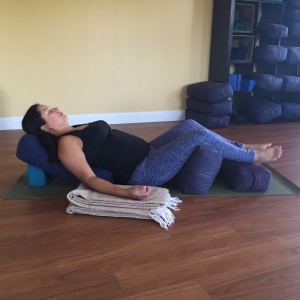If you’ve ever wondered whether you’re relaxing “correctly” in the final relaxation posture (aka śavāsana) in yoga class, this post is for you!
Śavāsana (shah-VAH-sah-nah), which translates as Corpse Posture, is the relaxation posture typically used at the end of the yoga āsana (AH-sah-nah) practice. It can also be used as a resting posture any time throughout āsana practice.
In this posture, the body lies supine (face up) with the arms and legs relaxed and positioned slightly out toward the sides. Palms typically face up. The neck should be in a neutral position, so for people who have a lot of tightness in their neck and/or shoulders, it may be necessary to use a small prop behind the head, such as a folded blanket or small pillow.
That said, there are many, many variations for śavāsana.
There are variations in purpose (Why are we doing this śavāsana? What do we hope to achieve?).
There are variations in method (How do we want to accomplish the goal of this śavāsana?).
There are variations is body positioning (Should we lie flat? Use props? Lie still? Change position?).
So if you’ve ever wondered whether you’re relaxing “correctly,” the answer is, “It depends!”
Purposes of Śavāsana
There are three main purposes of Śavāsana.
The first is to establish a sense of deep relaxation, which is great for people who are very stressed, ill, or who are recovering from illness or injury.
The second is to allow the body time to rest and regain homeostasis (resting heart rate, resting rate of respiration) after performing vigorous āsana postures or sequences.
The third is to practice focusing the mind, which is beneficial for all people.
Śavāsana for Deep Relaxation
If the goal of Śavāsana is deep relaxation, the teacher may do a guided relaxation practice. In this case, you’ll be lying still for at least 10 minutes, so you’ll want to position your body in a very comfortable way.
For example, you might consider lining your mat with a layer of folded blanket for more padding. You might like to elevate your legs with a bolster (or two) behind your knees or lower legs. You might even build a recliner with a block and a bolster. The possibilities are endless. Try one of more of these suggestions, or ask your teacher for personalized guidance in creating a relaxation posture that suits your needs or goals.
Once you’re in a comfortable position, the teacher will begin a slow-paced set of instructions for systematically relaxing the body. You’ll just lie still, breathe naturally, listen to the instructions, and follow along. You can close your eyes to block out visual distraction if that feels comfortable for you.
The relaxation instructions are sometimes referred to as Yoga Nidra (NIH-drah). Nidra translates as Sleep, but the goal of relaxation is not necessarily to fall sleep. (Unless you are practicing Yoga Nidra for insomnia, in which case it would be ok to relax and fall sleep. See? Like I said, It depends!)
During deep relaxation, it’s common to feel as if you’re falling asleep, or you may actually drift in and out of sleep, especially if you’re sleep deprived. You might even hear one of your classmates quietly snoring.
Nevertheless, do try to stay awake and aware of the teacher’s instructions. Allow your body and mind to deeply relax. If you do end up falling asleep, don’t stress about it, just try again next time!
Śavāsana for Resting
This type of śavāsana gained new meaning for me during my January training in India. Theidea is to rest intermittently throughout the āsana practice, pretty much any time your breathing becomes labored.
I found this practice fascinating for a number of reasons.
First, it helps the practitioner become more self-aware by noticing the inner workings of your body. You learn to notice your deeper, harder breathing. You learn to feel when your heart is working harder.
When your body experiences strain, stop and lie down for a minute or two to take a relaxation break.
This type of śavāsana is an important differentiator between yoga and exercise. In exercise, we intentionally raise our heart rate for cardiovascular health and perhaps weight loss. In yoga, we’re using the body to teach the mind to focus. This Rest Śavāsana is a perfect example of how we use the body to train the mind.
This Rest Śavāsana is a great life lesson too. Rather than “stressing out,” “pulling an all-nighter,” “needing coffee, stat!”, “shopping till we drop,” “working hard and playing hard,” and “no pain, no gain,” we train ourselves to rest once in a while. It’s a great habit to help manage our stress levels and improve our overall health.
Śavāsana for Mental Focus
From the śavāsana posture, one can perform most any kind of breathing practice, the purpose of which one would think is to improve the breathing, but perhaps more importantly, is to train the mind to focus on something subtle (breathing).
The breathing practice can be done on its own, before or after a Relaxation Śavāsana, or during or after a Rest Śavāsana.
Depending on a number of factors, the teacher might cue you to focus on some aspect of the breathing, such as how it feels, counting the duration of the breath, coordinating a simple movement with the breath, or even mentally chanting a mantra on the exhales.
These different types of focus are designed to help you train your brain, improve your ability to quiet your mind, and focus on only one thing at a time.
So now you see how the śavāsana posture is very versatile and can be used in a variety of applications. There isn’t really a “right” or “wrong” way to practice, there’s just different ways to practice.
Do you have a question about yoga you’d like me to answer? Email it to me and I’ll be happy to answer in a future newsletter.
Have a great week!
All my best,
Zelinda
P.S. If you found this post useful, please share it!


 But the good news is that relaxation practices can help undo some of the harmful effects of stress. Some of our regular, long-term students have managed their stress and improved their health so much that their doctors have reduced or even eliminated their blood pressure or diabetes medication. There are real benefits to learning how to relax.
But the good news is that relaxation practices can help undo some of the harmful effects of stress. Some of our regular, long-term students have managed their stress and improved their health so much that their doctors have reduced or even eliminated their blood pressure or diabetes medication. There are real benefits to learning how to relax.